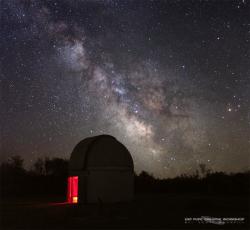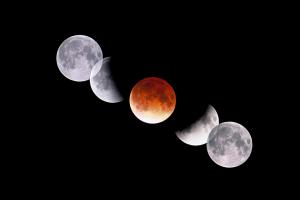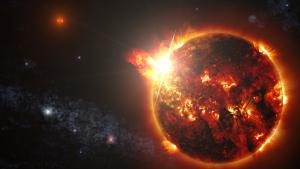
Public Stargazing
- Where:
- Frosty Drew Observatory
- When:
- Friday October 3, 2014 at 7:30 p.m. - 10:00 p.m.
- Cost:
- $1 Suggested Donation per Person
Tonight's forecast is calling for partly cloudy skies becoming cloudy by midnight. The 71% waxing gibbous Moon will be overhead at sunset and will stay with us until 2:03 a.m. If skies permit, we plan to open for stargazing tonight from 7:30 p.m. until 10:00 p.m. We will start off the night with views of the Moon and possibly Saturn. As the night progresses, binary stars will be on display as the bright waxing gibbous Moon will obscure many deep sky objects. Though clouds will ultimately dominate the night sky, we could have some excellent lunar views early before clouds set in.
Please note that Frosty Drew Observatory is offering a partial program tonight with only the 10” Art Gurarino telescope available for viewing in the observatory court yard. The observatory will be open though the primary 16” telescope will not be available for stargazing. We will return to our regular stargazing schedule next Friday.
-------------------------------------------------------------------------
Weekly Happenings
Scott MacNeill
This coming Wednesday, October 8th, set your alarm early and trek out to catch the second total Lunar Eclipse of 2014. Unlike the total Lunar Eclipse on April 15th, the timing of this eclipse is certainly not optimal, with the best part of the eclipse happening during Sunrise for East Coast watchers. For those willing to get out under the pre-dawn skies, the penumbral stage of the eclipse will happen at 4:15 a.m. EDT when the Moon passes into Earth's secondary shadow, called the “penumbra”. The penumbral stage will present itself as a dimming of the western side of the Moon. 5:15 a.m will bring the start of the partial eclipse stage. During this stage, the Moon begins its pass into Earth's primary shadow, called the “umbra”. This is when the eclipse becomes clearly visible as a chunk of the Moon begins to disappear from our view. At 6:25 a.m. the total eclipse stage begins. At this point, the entire Moon is engulfed in Earth's umbra and will dimly shine with a ruddy red color. Sunrise happens at 6:55 a.m. Wednesday morning, giving us near 30 minutes of total eclipse viewing. Since the Moon will set and the sun will rise for New England sky watchers during the total eclipse period, views of the total eclipse will fade quickly.
Comfortably eclipse watching will require a jacket, clear skies, an unobstructed view of the Western horizon, and much enthusiasm. To add a little geekage to awesome, Uranus and the Moon will be in conjunction during the eclipse and will appear approx. 1° from each other. So whether you are up for the eclipse or just starting your day, step outside and catch a glimpse of the second total Lunar Eclipse of 2014.
This past week the numbers are in for an awesome celestial event that happened this past Spring and they are huge! On April 23rd, while monitoring gamma ray burst activity, the NASA Swift mission's Burst Alert Telescope (BAT) was slammed with a massive burst of radiation. Upon detecting this significant rise in X-rays, Swift quickly re-position itself towards the constellation Canes Venatici to observe the source of the burst. The culprit, a dim star system called DG Cvn, which had released a solar superflare of the likes we have never seen from a star this size.
At 60 light years distant from Earth, DG CVn is a small binary star system comprised of two red dwarf stars. The companion stars of DG CVn are each about 1/3 the mass and size of the Sun. Both stars orbit each other at three times the distance Earth is from the Sun. DG CVn is estimated to be about 30 million years old, making it less than 0.7% the age of the Solar System.
The superflare that erupted on April 23rd, was so catastrophic that for a period of three minutes the brightness of the flare was greater than the combined star light of both stars. Temperatures of the flare during its peak period reached a balmy 360,000,000º F, which is more than 12 times as hot as the core of the Sun. The largest solar flares monitored on the Sun are classified in the “X” class, with the largest recorded X-class flare happening during November 2003 rated at X45. Well DG CVn's superflare on April 23rd would have been classified at X100,000!
A key factor in the cause of a flare this size is the fast spin rate that DG CVn's stars have. The spin rate, at 30 times faster than the Sun's axial rotation, amplifies magnetic fields. The fast rotation period of DG CVn is similar to the faster rotation the Sun experienced in its youth. Though the Sun today is incapable of producing X100,000 class flares (sorry doomsayers, no vaporizing of the species today), there may have been a time in its infancy when superflares were not so uncommon in our little corner of celestial awesome.
-Scott


